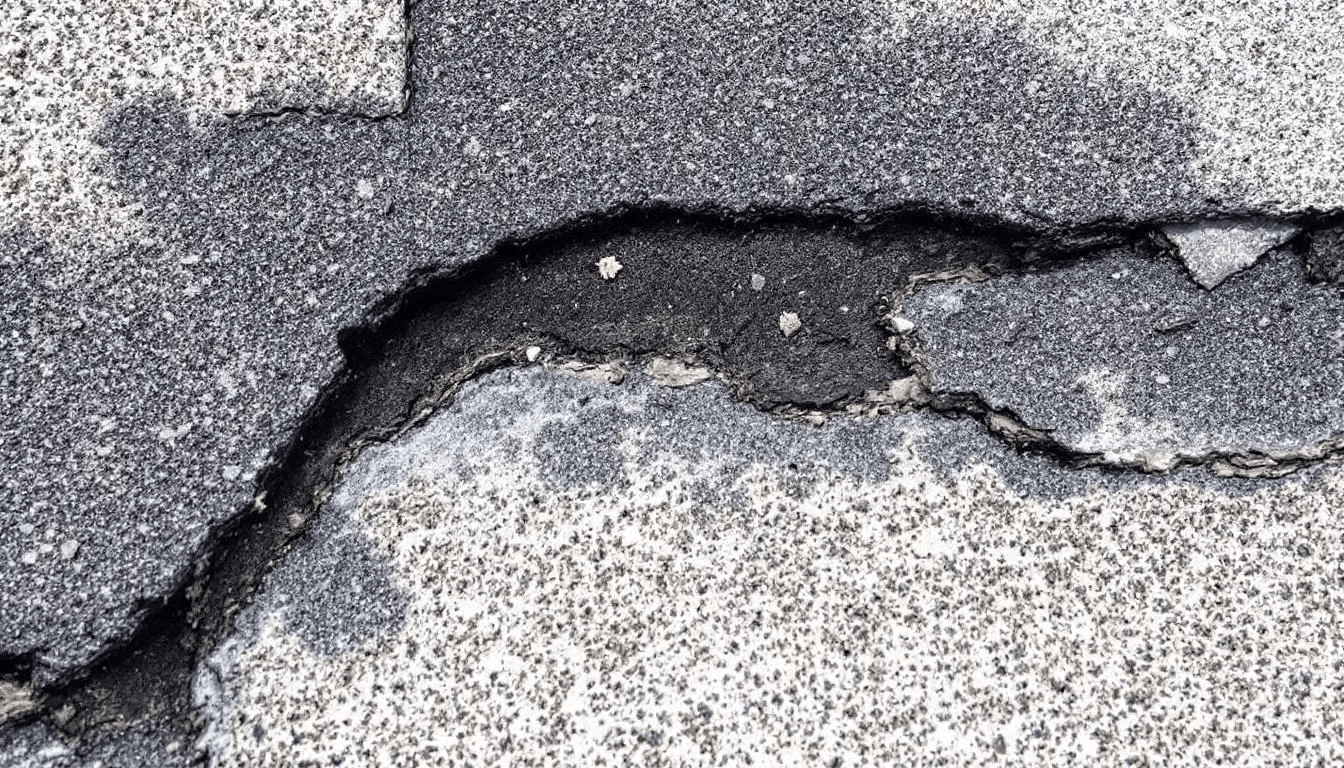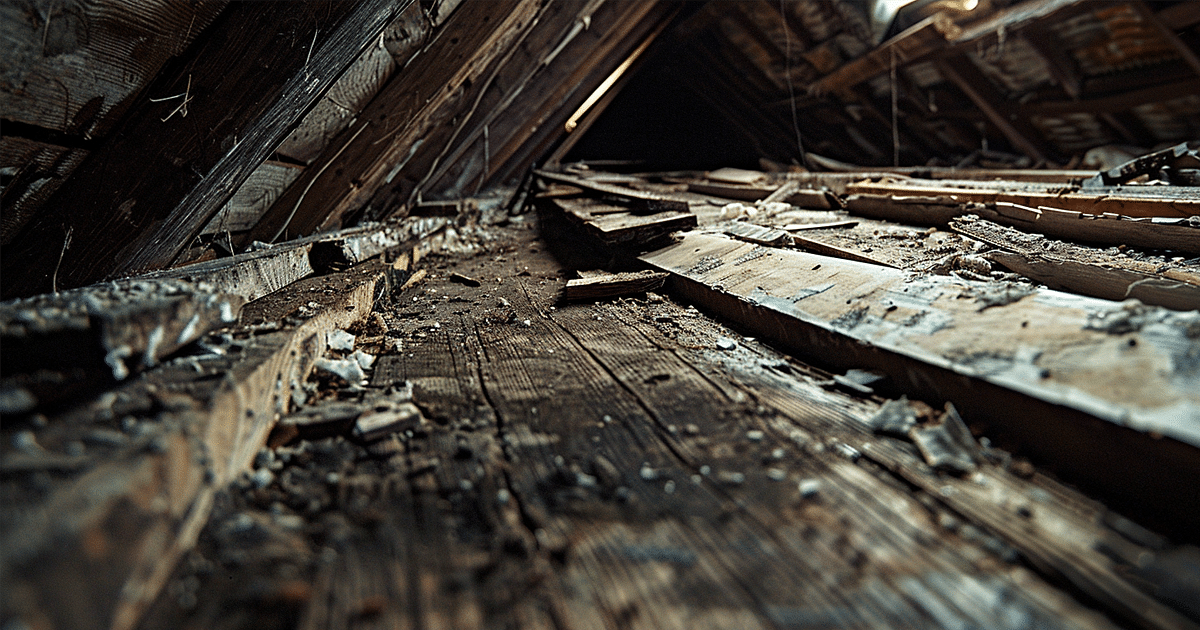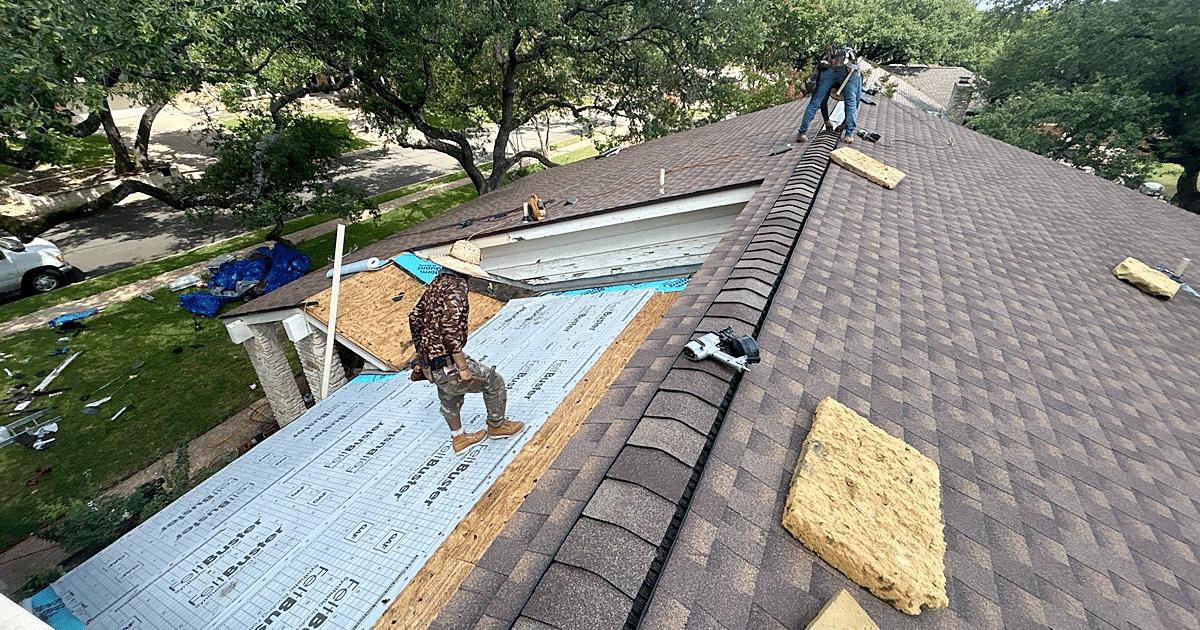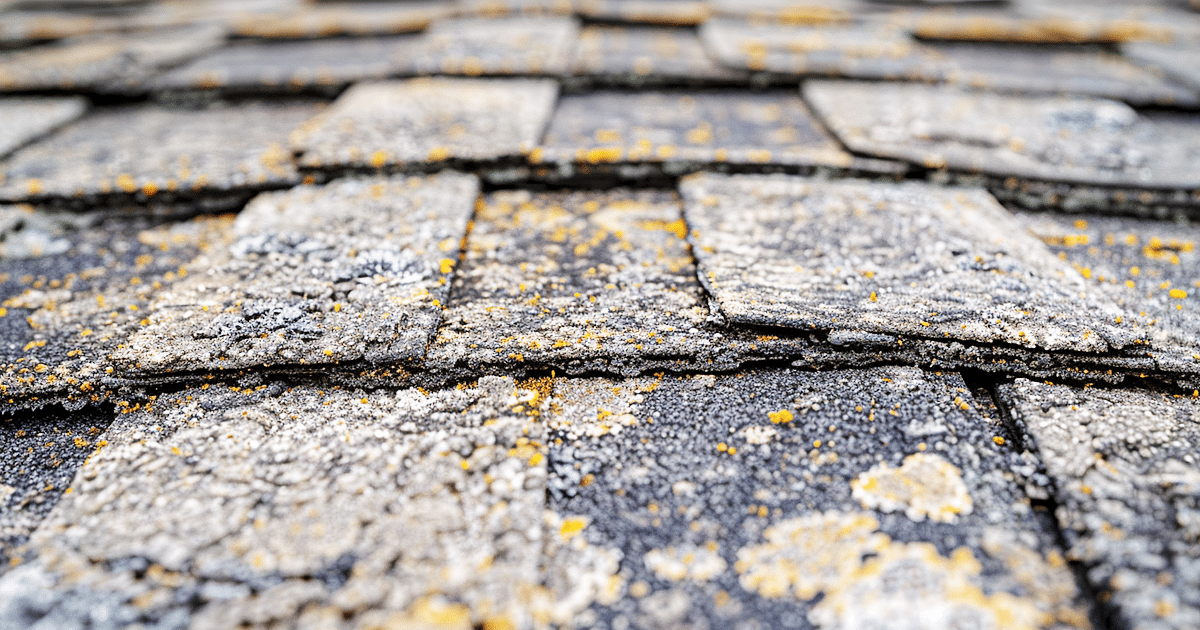When homeowners try to cut costs on roofing materials, it might seem like a harmless way to save money—until the consequences start showing up overhead. The quality of your roofing materials directly impacts how well your roof holds up against Central Texas heat, hail, and humidity. Using cheaper products can lead to faster deterioration, leaks, and expensive structural damage later on. What looks like a small savings upfront often ends up costing far more in repairs, replacements, and even interior restoration work down the line.
Key Takeaways
- Using substandard roofing materials can reduce your roof’s lifespan by 50% or more, turning a 30-year investment into a costly 10-15 year cycle of repairs and replacement
- Cheap materials like thin asphalt shingles and inferior underlayment typically fail within 5-10 years, leading to structural damage, mold growth, and repair costs exceeding $20,000
- The long-term financial impact of cutting corners includes frequent repairs every 3-5 years, increased energy costs of 15-25%, and potential home value reduction of 10-20%
- Quality roofing materials from reputable manufacturers offer 25-50 year warranties compared to 10-15 years for budget options, providing better long-term value despite higher upfront costs
- Proper material selection and professional installation prevent catastrophic failures that can compromise your home’s structural integrity and your family’s safety
When faced with a significant roofing project, many homeowners are tempted to save money by choosing cheaper materials or working with discount roofers. However, cutting corners on roofing materials creates a false economy that can cost tens of thousands more in the long run. Understanding the true cost of substandard roofing materials helps homeowners make informed decisions that protect both their investment and their family’s safety.
The consequences of poor material choices extend far beyond initial savings. While a quality roof using high quality materials might cost more upfront, the long-term value becomes clear when you consider the shortened roof lifespan, frequent repairs, and potential structural damage that result from cheap materials and poor installation.
Immediate Consequences of Substandard Roofing Materials
The problems with low quality roofing materials don’t wait decades to manifest. Within the first 2-3 years after installation, homeowners often notice visible signs that signal future problems. These early warning signs represent just the beginning of a cascade of issues that will plague the roof throughout its dramatically shortened lifespan.
Granule loss represents one of the most immediate and visible consequences of cheap asphalt shingles. While quality materials lose less than 5% of their granules in the first five years, budget shingles can lose 30-40% of their protective granule coating within the same time frame. This granule loss exposes the underlying asphalt to UV damage, accelerating the aging process and creating a roof vulnerable to weather damage.

Extreme weather events reveal the true quality of roofing material almost immediately. Budget shingles begin curling, cracking, and blistering when exposed to temperature fluctuations that quality materials handle without issue. Poor weather resistance becomes apparent when cheap materials suffer wind damage at speeds as low as 60 mph, while properly installed high quality materials can withstand winds exceeding 130 mph.
The aesthetic impact hits homeowners immediately and continues to worsen. Visible deterioration not only affects curb appeal but also signals to potential buyers that the home has maintenance issues. This immediate impact on property value represents money lost from the moment the new roof installation is complete.
Most homeowners don’t realize that their roofing contractor may be using mismatched materials or skipping critical components to meet aggressive pricing. Missing shingles after the first storm season often indicate that inadequate fastening or inferior adhesive strips were used during the original installation.
Material-Specific Long-Term Failures
Asphalt Shingle Degradation
The difference between quality and budget asphalt shingles becomes stark over time. Premium architectural shingles maintain their integrity for 25-30 years, while 3-tab budget shingles show significant deterioration within 10-15 years. This degradation follows predictable patterns that experienced roofing contractors recognize immediately.
Temperature cycling creates the most stress on roofing materials. Budget shingles lack the polymer modifiers that help quality materials expand and contract without cracking. In climates with significant temperature variations, thin shingles become brittle and develop stress fractures that allow water infiltration within 5-7 years.
Algae and moss growth accelerate the deterioration of untreated budget shingles. While quality manufacturers include algae-resistant granules, cheap materials provide no protection against biological growth. This organic growth retains moisture against the shingle surface, reducing the roof’s lifespan by 5-8 years and creating unsightly black streaking that damages property value.
Wind uplift failures plague budget shingles due to inadequate adhesive strips and inferior fastening specifications. When manufacturers cut corners on adhesive placement or use lower-grade sealants, individual shingles lift and tear during moderate wind events, creating immediate leak points and exposing underlying materials to weather damage.
Underlayment and Moisture Barrier Failures
The choice between traditional 15-pound felt and synthetic underlayment dramatically affects long-term performance. While felt underlayment costs less initially, it degrades within 5-10 years, while synthetic materials maintain their protective properties for 25+ years. This seemingly small material choice can determine whether water damage becomes a chronic problem.
Water infiltration through deteriorated felt creates a domino effect of structural problems. As the organic felt breaks down, it allows moisture to reach the roof deck, causing rot that spreads to rafters and structural supports. The hidden costs of this moisture buildup often exceed $15,000 in structural repairs before homeowners even notice interior damage.
In cold climates, inadequate moisture barriers contribute to ice dam formation. Budget underlayment lacks the self-sealing properties needed to prevent water backup when ice blocks gutters and drainage systems. The resulting water intrusion can damage insulation, drywall, and electrical systems throughout the home.
Vapor barrier failures create another hidden problem as cheap materials allow moisture migration from the home’s interior into the attic space. This moisture condenses on cold surfaces, saturating insulation and creating conditions ideal for mold growth and structural decay.
Flashing and Sealing Material Deterioration
The difference between proper metal flashing and cheap alternatives becomes apparent within years rather than decades. While caulk and mastic sealants might cost less initially, they require replacement every 2-3 years compared to properly installed metal flashing that lasts 20+ years without maintenance.
Galvanized steel flashing represents a common compromise that creates long-term problems. While initially functional, galvanized materials rust through within 8-12 years in most climates, compared to aluminum or copper flashing that provides protection for 30+ years. This premature failure often occurs around the most critical components like chimneys and vent penetrations.
Sealant failures around penetrations create the most common leak points in budget roofing systems. Professional roofers understand that proper flashing design eliminates the need for sealants in primary water-shedding areas, but cheap installations rely heavily on caulks that inevitably fail.
Step flashing deterioration along walls and dormers creates particularly serious problems because water intrusion at these locations can damage both roofing and siding systems. Poor installation or inferior materials in these areas often leads to wall and foundation water damage that costs more to repair than the original roofing project.
Structural and Safety Consequences
The structural implications of cutting corners on roofing materials extend far beyond the roof itself. Water intrusion from failed materials creates a cascade of problems that can compromise the entire home’s structural integrity while creating serious health and safety hazards for occupants.
Deck deterioration represents the most serious structural consequence of poor roofing materials. When underlayment fails and allows water to reach the roof deck, the resulting rot spreads rapidly through the structural system. Replacing damaged decking, rafters, and trusses typically costs $8,000-15,000, often more than the original budget roofing project.

Prolonged water exposure weakens the most critical components of the roof structure. Rafters and trusses lose load-bearing capacity as moisture causes dimensional lumber to warp, crack, and rot. In extreme cases, structural instability requires emergency repairs to prevent collapse.
Insulation damage from moisture intrusion creates multiple problems beyond structural concerns. Wet insulation loses its R-value, increasing energy costs by 15-25% while creating conditions perfect for mold growth. Compressed or damaged insulation requires complete replacement and often reveals extensive hidden damage to surrounding structural components.
Mold growth represents both a health hazard and a major financial liability. Professional mold remediation costs $10,000-30,000 in severe cases, and some insurance policies exclude coverage for mold problems resulting from maintenance neglect. The health risks from prolonged mold exposure can affect respiratory systems and create liability issues for property owners.
Fire safety hazards develop when deteriorated roofing materials expose electrical systems to moisture. Water intrusion into electrical boxes and wiring creates short circuits and fire risks that endanger occupants while potentially voiding insurance coverage.
Poor insulation and inadequate ventilation from budget materials create ice dam conditions that can damage gutters, siding, and landscaping. The weight of accumulated ice can also stress structural components beyond their design limits.
Financial Impact Over 20-30 Years
The true financial impact of cutting corners on roofing materials becomes clear when analyzing costs over the typical home ownership period. A comprehensive cost comparison reveals that budget materials often cost twice as much over 25 years despite lower initial prices.
Consider this realistic example scenario: a $15,000 quality roof using high quality materials versus an $8,000 budget installation. The quality roof provides 25-30 years of service with minimal maintenance, while the budget roof requires major repairs every 5-7 years and complete replacement within 15 years.
| Cost Category | Quality Materials (25 Years) | Budget Materials (25 Years) |
|---|---|---|
| Initial Installation | $15,000 | $8,000 |
| Major Repairs | $2,000 | $12,000 |
| Replacement | $0 | $10,000 |
| Energy Costs (additional) | $0 | $3,000 |
| Total Cost | $17,000 | $33,000 |
Repair frequency represents a major hidden cost of budget materials. While quality roofing requires maintenance every 10-15 years, budget materials need attention every 3-5 years. Emergency repairs during severe weather often cost 2-3 times normal rates, adding thousands to the total cost of ownership.
Energy cost increases from poor insulation and ventilation systems compound annually. A roof that allows 20% more energy loss costs the average homeowner $200-400 per year in additional heating and cooling expenses. Over 20 years, this energy penalty equals $4,000-8,000 in additional costs.
Insurance considerations add another financial dimension to material choices. Many homeowners discover that insurance companies deny claims for damage resulting from known defective materials or deferred maintenance. This leaves property owners responsible for both the original damage and any consequential losses.
Home resale value suffers immediately and continuously with budget roofing materials. Real estate professionals report that homes with obviously deteriorated roofs sell for 10-20% less than comparable properties with quality roofing. Buyer inspection failures often require costly concessions or complete roof replacement before closing.
Financing options for frequent repairs create additional costs through interest and fees. Homeowners with budget roofs often find themselves financing repair work multiple times throughout the roof’s shortened lifespan, adding thousands in interest costs to the total expense.
Warranty and Insurance Implications
The warranty differences between quality and budget materials reveal manufacturers’ confidence in their products. Premium roofing materials typically include comprehensive warranties covering 25-50 years, while budget options offer limited 10-15 year coverage with numerous exclusions.
Manufacturer warranties on quality materials often include labor coverage and transferability to new homeowners. These warranties specifically require proper installation by certified contractors using approved techniques and complementary materials. Cutting corners on installation typically voids these valuable protections.
Insurance coverage limitations become apparent when budget materials fail prematurely. Many policies exclude coverage for damage resulting from inadequate maintenance or known defective materials. Homeowners who chose cheap materials to save money often discover they’re responsible for expensive repairs that quality materials would have prevented.
Voided warranties represent a common problem with budget installations. When roofing contractors use inferior fasteners, skip proper ventilation, or ignore manufacturer guidelines to reduce costs, they invalidate the material warranties. This leaves homeowners without recourse when premature failures occur.
Legal liability issues can arise when material failures cause property damage beyond the roof itself. Water damage to personal property, mold-related health issues, and structural problems may not be covered by standard insurance policies if the damage results from known defective materials or poor workmanship.
Professional liability for contractors using substandard materials creates additional risks. Many experienced roofing contractors refuse to install budget materials because the resulting failures can damage their reputation and expose them to liability claims.
Building codes increasingly specify minimum material standards for new construction and major renovations. Homeowners who installed non-compliant budget materials may face costly upgrades when selling or refinancing their property.
How to Avoid Long-Term Material Consequences
Preventing the long-term consequences of cutting corners starts with understanding how to identify and select appropriate materials for your specific climate and home design. Working with reputable manufacturers and experienced roofing contractors provides the best protection against premature failure and costly repairs.
Selecting reputable manufacturers like GAF, CertainTeed, Owens Corning, Atlas, Tamko, and IKO ensures access to quality materials backed by comprehensive warranties. These manufacturers invest heavily in research and development to create products that withstand specific regional weather challenges while providing long-term value.
Understanding material specifications helps homeowners make informed decisions about their roofing project. Impact resistance ratings, wind speed certifications, and fire ratings provide objective measures of material performance. Quality materials consistently exceed minimum building codes while budget options often barely meet basic requirements.

Investing in proper installation techniques that complement quality materials ensures optimal performance throughout the roof’s lifespan. This includes following manufacturer guidelines for fastener placement, underlayment overlap, and ventilation requirements. Experienced roofing contractors understand that proper installation maximizes material performance while maintaining warranty coverage.
Regular inspection schedules help identify early material degradation before it becomes a major problem. Annual inspections by qualified professionals can detect loose shingles, damaged flashing, or developing leaks while repairs remain minor and affordable. These preventive measures protect both the roofing investment and the home’s structural integrity.
Working with certified contractors who refuse to compromise on material quality provides assurance that the roofing project will deliver long-term value. Reputable roofing companies understand that their reputation depends on customer satisfaction years after installation, making them natural allies in selecting appropriate materials.
Adequate insurance coverage protects against unforeseen events while ensuring that quality repairs maintain the roof’s integrity. Many homeowners discover too late that their insurance requires specific material grades or installation standards to maintain coverage in high-risk areas.
Professional roofers with adequate insurance and current licensing provide additional protection against installation errors or material defects. These contractors stand behind their work and have the resources to address problems that might arise during the warranty period.
FAQ
How much more do quality roofing materials cost compared to budget options initially?
Quality roofing materials typically cost 30-50% more initially than budget options, but this difference is often smaller than homeowners expect. For example, architectural shingles from premium manufacturers might cost $150-200 per square versus $80-120 for basic 3-tab shingles. However, when you factor in the longer lifespan, better warranties, and reduced repair frequency, quality materials provide better long-term value and lower total cost of ownership over 20-30 years.
Can I upgrade individual components like underlayment while keeping budget shingles?
While upgrading specific components like synthetic underlayment can improve performance, mixing quality and budget materials creates an unbalanced system where the weakest component determines overall performance. Budget shingles will still fail prematurely regardless of high-quality underlayment, and the improved underlayment warranty may be voided if installed with non-approved roofing materials. For optimal performance and warranty protection, it’s better to use a complete system of compatible quality materials.
What are the warning signs that my roof materials are failing prematurely?
Early warning signs include excessive granule loss in gutters, curling or cupping shingle edges, visible cracking or splitting, missing shingles after moderate weather, and algae or moss growth. Inside the home, look for water stains on ceilings, increased energy bills, ice dams in winter, and musty odors that might indicate mold growth. If your roof shows these signs within 10-15 years of installation, the materials or installation likely cut corners that are causing premature failure.
Do insurance companies require specific material grades for coverage in high-risk areas?
Yes, many insurance companies now require specific impact resistance ratings, wind speed certifications, or fire ratings for coverage in areas prone to hail, hurricanes, or wildfires. Some insurers offer discounts for homes with Class 4 impact-resistant shingles or other premium materials that exceed local building codes. Conversely, some budget materials may not meet insurance requirements, potentially affecting coverage or premium rates. Always verify material requirements with your insurance provider before starting a roofing project.
How do I verify that a contractor is actually using the quality materials I’m paying for?
Request material delivery receipts showing manufacturer names and model numbers and verify these match your contract specifications. Reputable contractors welcome material inspections and provide documentation from suppliers. Check that packaging and labeling on delivered materials match what you ordered, and be present during delivery when possible. Ask for photos of materials before installation begins, and don’t make final payment until you receive manufacturer warranty documentation that proves quality materials were properly installed according to specifications.



